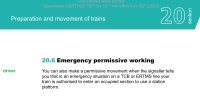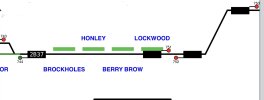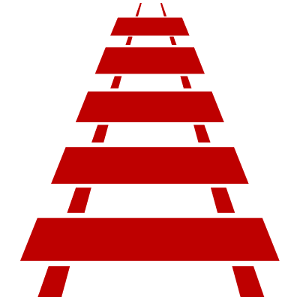Nottingham59
Established Member
ERTMSWhat would be the best type of signalling for a single line with reasonably spaced loops along the way - especially for a route such as Highland Main Line?
ERTMSWhat would be the best type of signalling for a single line with reasonably spaced loops along the way - especially for a route such as Highland Main Line?
The signalling would depend on the traffic, but single lines with loops usually don't have trains following closely enough for there to be more than one train between a loop and the next loop. Otherwise a train going the other way would have to hang around in the loop until both trains have passed. So the best arrangement with conventional signalling is probably pretty much what it has now - which I think is a distant on the approach to each loop then a signal protecting the loop entry and another protecting both the loop exit and the section to the next loop.What would be the best type of signalling for a single line with reasonably spaced loops along the way - especially for a route such as Highland Main Line?
On another note, Some single lines such as the Lea Valley 3rd track from Lea Bridge to Meridian Water are almost like a long siding, where I am assuming that modern interlocking prevents another train being routed onto it until the occupying train has exited. And I'm assuming special procedures are in place if another train has to enter the section to rescue it. Would I be right in thinking that Watford to St Albans, Witham to Braintree and Marks Tey to Sudbury are similar examples?
The AB system is generally associated only with double lines.
Yes.Can/Do you get Permissive working in AB areas ?
Of courseBut as it’s the railway, there’s always exceptions to that rule
Yes.
No, emergency permissive is TCB only isn't it?Awesome and thanks.
Follow up.....
I assume Emergency Permissive could still be applied (yeah, I know)
Ta
Exactly.Unless I’m missing something - and I’m not a signaller, so I might be(!) - the diagram just shows two trains being separated by signalling section, which is the same thing that happens routinely on all TCB lines?
Two trains in one signalling section, rather than one single line section, is the big no no (other than under permissive working, assistance etc.) AIUI under TCB single line sections have a direction of flow device that interlocks signals to allow working in each direction, but other than that it’s operation as usual.
The tunnels on the Hastings Line are a good example of this “in the wild”, as is the line from Crystal Palace to Beckenham Junction.
No, emergency permissive is TCB only isn't it?
For unidirectional lines, there is no signalled route (except maybe for shunting purposes, and hence a limit of shunt signal) for a train to enter in the wrong direction. Hence the system does not need directional interlocking and direction controls.I'm jumping in to ask something a bit different, but more or less consistent with the thread title. With conventional semaphore signalling, absolute block (or permissive block for slow freight trains) was normal for two-track lines but not for single-track, hence the need for token/tablet/staff. The West Highlind line now has RETB, which is a modern equivalent. But trains on modern bi-directional tracks are controlled by the same systems as on unidirectional tracks. Why do those lines not need anything additional?
No, emergency permissive is TCB only isn't it?
Err.... No idea. I would think the principle is the same. Pass the signal at Danger, drop into the platform, hero landing, pop the doors and then Robert's your Brother's Uncle. I don't think the rulebook makes the distinction but thinking about it, I don't see any real reason why not.



To the best of my knowledge:Trying to think of a through station with permissive platforms that falls wholly within "station limits" (in the signalling sense) of one box working AB – any offers? The principle there is similar to permissive working on a TCB line.
But Wirral Line trains can exit the loop and terminate in the emergency platform at James Street?Not really the same thing, as these are always used in the same direction so just like one track of a double track really.
To the best of my knowledge:
In terms of terminus stations I'm aware that the following are permissively worked on AB lines:
And for through platforms:
- All Holyhead platforms
- All Llandudno platforms
- All Penzance platforms
- All Scarborough platforms (technically Seamer works AB to Weaverthorpe)
- All Saltburn platforms
- The bay at Whitehaven Bransty
- The bay at St Erth
- The bay at Whitby (though NST-R)
- The bay at Barrow-in-Furness
- The bay at Llandudno Junction
- The bay at Bridlington.
- All lines at Llandudno Junction
- All lines at Worcester Shrub Hill (including from one of the famous banjo signals)
- All lines at Harrogate
- All through lines at Stirling (albeit two are also under the juristiction of Stirling North)
- The two through lines at Barrow-in-Furness
- The through platform at Whitehaven Bransty
- The platform lines at Bangor
- Some of the lines at Hereford
- Potentially one of the through lines at Bridlington but I'm not entirely sure.
It seems like quite a few of the stations listed are in TCB territory, even though the controlling signal box may work AB to the next box.The sectional appendix shows Llandudno Junction as being TCB these days.
It’s TCB or ERTMS only. Described in clause 3.4 in modules TS2 and TS10 respectively. Module TW1 contains the balancing instruction for
Doesn't change the fact the loop itself is uni-directional.But Wirral Line trains can exit the loop and terminate in the emergency platform at James Street
For coupling up there is normally a subsidiary aspect indicating to the driver that they can proceed but must stop short of any obstruction, in this case the train they are coupling to. In semaphore areas this is typically a small arm or disc, and in colour light areas it is two small white lights at an angle, in both cases underneath a main signal that remains at danger.Presumably there are exceptions to all this for situations where trains couple up or assisting a failed train?
I have to say that, as a former signalman, every time I see the thread title I give a little start of horror. It is the signalman’s worst nightmare.
Llandudno Junction works TCB to Wales ROC Rhyl Workstation, ETB to Llanrwst, and AB to Deganwy and Penmaenmawr. It has three home signals and three section signals, and through routes are possible between them, so technically speaking the platforms could be said to be inside station limits as Tomnick was asking for.The sectional appendix shows Llandudno Junction as being TCB these days.
ERTMS L2/3, from a purely operational POV. There's various talks about making RETB smoother though with things like returning tokens on the move and 'collapsible' tokens, not sure how far they got.What would be the best type of signalling for a single line with reasonably spaced loops along the way - especially for a route such as Highland Main Line?
Presumably this is dealt in a similar way to how fully-signalled Bi-Di is controlled as well.On another note, Some single lines such as the Lea Valley 3rd track from Lea Bridge to Meridian Water are almost like a long siding, where I am assuming that modern interlocking prevents another train being routed onto it until the occupying train has exited.
I wouldn't have thought the procedures would need to be particularly different from any other procedure to enter an occupied signal section to rescue a failed train. Signaller talks past signal at Danger, driver proceeds at caution etc.And I'm assuming special procedures are in place if another train has to enter the section to rescue it. Would I be right in thinking that Watford to St Albans, Witham to Braintree and Marks Tey to Sudbury are similar examples?
I think the french signalling system is permissive by default (open to correction and all the specific exemptions of course), and their operating rulebook presumably covers situations of reduced visibility.Fifty years ago in 1974 I was travelling on SNCF's couchette/sleeping-car Train 400 from Calais Maritime to Ventimiglia/Vintimille. After a crew-change stop in the north of Paris we joined the Grande Ceinture peripheral railway to circumnavigate the banlieues anti-clockwise and access Gare de Lyon from the south where we would reverse, add the Paris portion and change engine.
Peering out from my compartment in the dark on the Grande Ceinture I was astonished to see that we were closely following the rear flashing lights of another train just 200 metres ahead. The speed of both trains was no more than 30 km/h, so plenty of time to react if the first train suddenly stopped. Very much a case of "permissive working" and a flexible approach in increasing line capacity. But Heaven knows how they'd manage in fog and falling-snow!
Surely you went clockwise!Fifty years ago in 1974 I was travelling on SNCF's couchette/sleeping-car Train 400 from Calais Maritime to Ventimiglia/Vintimille. After a crew-change stop in the north of Paris we joined the Grande Ceinture peripheral railway to circumnavigate the banlieues anti-clockwise and access Gare de Lyon from the south where we would reverse, add the Paris portion and change engine.
Peering out from my compartment in the dark on the Grande Ceinture I was astonished to see that we were closely following the rear flashing lights of another train just 200 metres ahead. The speed of both trains was no more than 30 km/h, so plenty of time to react if the first train suddenly stopped. Very much a case of "permissive working" and a flexible approach in increasing line capacity. But Heaven knows how they'd manage in fog and falling-snow!
Every signal has a plate showing if it's permissive or not (F or Nf). Same applies to TVM block markers, with the ones over here on CTRL translated to P and N.I think the french signalling system is permissive by default (open to correction and all the specific exemptions of course), and their operating rulebook presumably covers situations of reduced visibility.
The line between Princes Risborough and Aylesbury is a good example of this, with the line divided into sections to allow "flighting" of trains in the same direction. In this case I believe it may be related to getting the trains through in the peaks
View attachment 155283
I think it is more that it alludes to two trains in a single section , which outside of occassions permitted in the rulebook is an operating irregularity that is taken quite seriously .Why? It's perfectly normal. I can think of at least one location on the network where a long single line section of around 7 miles was split in half by the installation of a new signal in each direction around halfway along, effectively splitting the section in two which instantly doubled the capacity of the line (for trains travelling in the same direction).
I travelled this line for the first time a few days ago, and saw that the HS2 bridge works appeared to form part of a recent provision for a passing loop between Aylesbury and Little Kimble, although as far as I can find out there are no current plans to actually build this loop (maybe someone has some better info on this?).Not related to getting trains through in the peaks but more allowing an increase in line capacity due to the amount of freight that uses the single line which used to cause many delays to Chiltern trains when there was only one long section.
